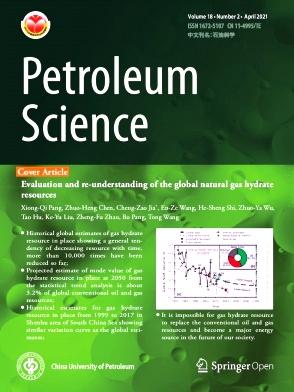基于模型解释层状地层基质处理过程中的井底压力记录
IF 6.1
1区 工程技术
Q2 ENERGY & FUELS
引用次数: 0
摘要
在注入处理过程中,井底压力测量结果可能与建模结果严重不匹配。我们设计了一种计算有效的技术,可根据井底压力测量结果解释多地质层井筒区间的注液情况。首先设定各层的渗透率、孔隙度和可压缩性,然后求解集肤系数和注入流体在注入过程中在各区之间的分配情况。该问题考虑了现代基质酸化处理中典型的达西流以及注入酸、分流流体和储层岩石之间的化学作用。利用同步记录的注入率和井底压力,我们评估了在不同的抽油作业(基质酸化、水控制、砂控制、水垢挤压和水淹)过程中各层的集肤因子变化以及实际流体在储层中的位置。通过与工业中使用的模拟器进行比较,对模型进行了验证。通过该模型,可以估算基质处理工作的效率、每个注入阶段的作用,并实时控制每层的流体输送。通过将流体力学模型与处理过程中的压力和注入率记录相结合,所提出的解释技术大大提高了基质处理分析的准确性。本文章由计算机程序翻译,如有差异,请以英文原文为准。
Model-based interpretation of bottomhole pressure records during matrix treatments in layered formations
During injection treatments, bottomhole pressure measurements may significantly mismatch modeling results. We devise a computationally effective technique for interpretation of fluid injection in a wellbore interval with multiple geological layers based on the bottomhole pressure measurements. The permeability, porosity and compressibility in each layer are initially setup, while the skin factor and partitioning of injected fluids among the zones during the injection are found as a solution of the problem. The problem takes into account Darcy flow and chemical interactions between the injected acids, diverter fluids and reservoir rock typical in modern matrix acidizing treatments. Using the synchronously recorded injection rate and bottomhole pressure, we evaluate skin factor changes in each layer and actual fluid placement into the reservoir during different pumping jobs: matrix acidizing, water control, sand control, scale squeezes and water flooding. The model is validated by comparison with a simulator used in industry. It gives opportunity to estimate efficiency of a matrix treatment job, role of every injection stage, and control fluid delivery to each layer in real time. The presented interpretation technique significantly improves accuracy of matrix treatments analysis by coupling the hydrodynamic model with records of pressure and injection rate during the treatment.
求助全文
通过发布文献求助,成功后即可免费获取论文全文。
去求助
来源期刊

Petroleum Science
地学-地球化学与地球物理
CiteScore
7.70
自引率
16.10%
发文量
311
审稿时长
63 days
期刊介绍:
Petroleum Science is the only English journal in China on petroleum science and technology that is intended for professionals engaged in petroleum science research and technical applications all over the world, as well as the managerial personnel of oil companies. It covers petroleum geology, petroleum geophysics, petroleum engineering, petrochemistry & chemical engineering, petroleum mechanics, and economic management. It aims to introduce the latest results in oil industry research in China, promote cooperation in petroleum science research between China and the rest of the world, and build a bridge for scientific communication between China and the world.
 求助内容:
求助内容: 应助结果提醒方式:
应助结果提醒方式:


